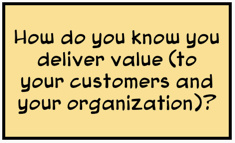Jak wynika z mojego doświadczenia i obserwacji, wciąż istnieje niewielkie zrozumienie, że Evidence-Based Management (EBM) jest empirycznym frameworkiem. Wymaga przejrzystości, częstych kontroli i dostosowań. Niektóre organizacje przeprowadzają wstępną ewaluację, a następnie rezygnują z pomysłu. Jednorazowe mierzenie i podejmowanie pewnych decyzji nie wystarczy! Nie ma gwarancji, że takie podejście zadziała.




Ten materiał został przygotowany przeze mnie, bez wsparcia AI.